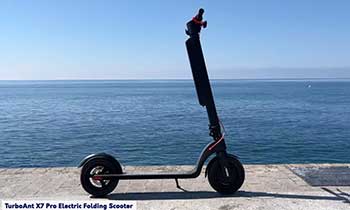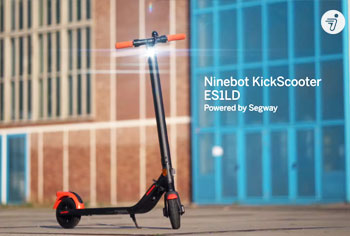Electric scooters have exploded in popularity in recent years as a fun, eco-friendly way to get around. Two of the biggest names in the electric scooter world are Turboant and Segway. But which one is better?
In this comprehensive guide, we’ll compare Turboant and Segway electric scooters side-by-side, looking at key factors like price, performance, features and more.
A Brief Comparison Table
| Feature | Turboant | Segway |
| Price | $199 – $499 | $429 – $799 |
| Motor Power | 300W – 500W | 300W – 600W |
| Max Speed | 15 – 18 mph | 15 – 18.6 mph |
| Range | 15 – 20 miles | 22 – 40+ miles |
| Build Quality | Good | Excellent |
| Brakes | Electric + Disc | Electric + Hydraulic Disc |
| Shocks | Basic | Advanced |
| App Connectivity | Some models | All models |
| Warranty | 6 months | 12 months |
Overview Of Turboant And Segway
First, let’s get an overview of each brand.

Turboant
Founded in 2016, Turboant is a relatively new player in the electric scooter market. But they’ve quickly made a name for themselves by offering feature-packed scooters at very affordable prices.
Turboant scooters are known for:
- Budget-friendly prices, usually under $500
- Impressive motors up to 500W
- Good build quality with aircraft grade aluminum frames
- Nice features like LED displays, cruise control, and app connectivity
Some of their most popular models include the Turboant X7 Pro and the Turboant M10.
Segway
Segway is one of the most well-known and reputable brands in electric vehicles. They introduced their first self-balancing “Personal Transporter” in 2001, which drew a lot of media buzz.
Today, Segway produces a wide range of electric scooters and other “last mile vehicles”. Some things they’re known for:
- Premium build quality with aircraft grade aluminum
- Powerful motors up to 600W
- Excellent battery life of over 40 miles
- High-end features like shock absorption, hydraulic brakes, and mobile app control
Their most popular electric scooters are the KickScooter ES1, ES2, ES3, ES4 and Ninebot Max.
Now let’s take a deeper look at how Turboant and Segway scooters compare across some key categories.
Price Comparison
The most obvious difference between Turboant and Segway is price. Turboant scooters are mostly in the $199 to $499 range. Segway scooters start around $429 and go up to $799.
Here’s a price comparison of some top models:
| Model | Price |
| Turboant X7 Pro | $399 |
| Turboant M10 | $499 |
| Segway ES2 | $569 |
| Segway Ninebot Max | $799 |
As you can see, Turboant scooters are generally $100 to $300 cheaper than comparable Segway models. This can make a big difference for budget-conscious buyers.
The lower prices of Turboant don’t mean they’ve compromised too much on quality either, as we’ll see next. But Segway does justify its higher prices with better batteries, motors and build quality overall.
Performance And Motor Power
Performance and power output is a key consideration for any electric scooter. Here’s how Turboant and Segway compare:
- Turboant scooters have motors ranging from 300W on basic models up to 500W on high-end models. Top speeds reach around 18 mph.
- Segway scooters also start with 300W motors on entry-level models but go up to 600W on premium models like the Ninebot Max. Top speeds can reach 18.6 mph.

In terms of acceleration and hill climbing ability, the more powerful Segway models have a clear edge. The 600W Ninebot Max accelerates briskly and can tackle steep inclines over 15% with ease.
But the 500W motors on the Turboant X7 Pro and M10 are still respectable. These can reach 15 mph and handle everyday hills and urban terrain just fine.
Casual riders who don’t need super speed or power can certainly get by with a 300-500W Turboant. But for maximum performance, Segway’s higher powered motors stand out.
Battery Life And Range
Range anxiety is a big concern with any electric scooter. You don’t want to run out of juice before reaching your destination.
For battery size and range, advantage Segway:
- Turboant scooters have batteries between 7.5Ah to 10Ah. This provides a typical range of around 15 to 20 miles real world.
- Segway scooters have larger batteries from 10Ah on the ES2 up to monumental 45Ah on the Ninebot Max. This results in real world ranges from 22 to 40+ miles per charge.
The Ninebot Max is incredibly impressive, able to cover over 40 miles even under demanding conditions. No Turboant model can match this range.
Turboant batteries are decent for shorter hops and commutes. But frequent riders or those without frequent charging access may want the extra range of Segway models like the ES4 (28 mile range) or Ninebot Max.
Build Quality
No one wants their scooter falling apart after a few months. So build quality is very important.
Both Turboant and Segway use aircraft grade aluminum alloy on their scooter frames for good durability. The overall build quality is pretty solid on both brands.
However, there are some differences:
- Turboant uses mostly plastic components like the handlebar, stem, and body covers. This helps keep costs down.
- Segway uses a higher percentage of metal parts including an aluminum alloy stem and carbon fiber handlebar on some models. This adds more structural rigidity.
- Segway also utilizes shock absorbing materials throughout its scooters more extensively. This improves ride comfort and longevity.
While cost-cutting is evident in some spots, Turboant doesn’t feel overly cheap or fragile during use. But Segway does have an edge in using higher quality components and materials overall.
Features
The more features an electric scooter has, the more versatile and convenient it becomes. Here’s a feature comparison:
Turboant Scooters
- LED display: Shows speed, battery level, riding mode. Available on most models.
- Cruise control: Maintains constant speed without holding throttle. Available on most models.
- App connectivity: Pairs to smartphone via Bluetooth on some models like X7 Pro. Enables extra settings, anti-theft, and firmware updates.
- Lights: Front LED headlight on most models. Some also have rear brake lights.
- Brakes: Electric + disc brake. Also has mechanical foot brake.
- Tires: 8-10 inch air filled tires with decent shock absorption.
Segway Scooters
- LED display: Shows speed, battery, Bluetooth connection, errors. Available on all models.
- Cruise control: Maintains set speed without holding throttle.
- App connectivity: Pairs to Segway app on all models. Provides firmware updates, detailed metrics, anti-theft and more.
- Lights: Bright front LED light plus rear brake light standard on all models.
- Brakes: Electric + hydraulic disc brakes for strong stopping power in all conditions. Also has foot brake.
- Tires: Front and rear shock absorption on all models. 10 inch air filled tires with good grip and ride comfort.
- Other features: Kick-start sensor, customizable lights, auto headlights, fast folding stem on some models.
While Turboant includes a decent feature set for the price, Segway takes things up a notch in this category with extras like hydraulic brakes, customizable lights via app, shock absorption and more.
The Segway feature set results in a more premium, customizable and technologically advanced riding experience overall.
Also Read: Is Gotrax G4 Better Than Hiboy S2 Pro?
Ride Handling And Comfort
How a scooter actually feels to ride is hugely important. You want smooth accelerating and braking, solid stability at speed, and good shock absorption so bumps don’t knock you around.
Here is how Turboant and Segway scooters compare in real world handling:
- Turboant scooters feel well balanced and tuned. The motor acceleration and braking feels smooth without being overly aggressive. The handlebar stems have some flex but still feel stable enough up to top speed. Shock absorption in the tires takes the edge off bumps. Overall the ride is quite good for the price point.
- Segway scooters have excellent stability and shock absorption that can be felt immediately. Even the ES2 has front and rear shock systems that noticeably smooth out bumps. And pricier models like the Ninebot Max have a very rigid yet shock absorbing frame that eats up bumps extremely well. Braking and acceleration are surgically precise thanks to the high quality components. Overall, Segway offers an unparalleled premium ride experience.
While Turboant scooters perform well for their class, Segway models like the Ninebot Max offer a clear step up in ride comfort and handling. This makes them better suited for long rides and rougher urban terrain.
Warranty And Post Purchase Support
No matter how well built and reliable a scooter is, problems can happen. So the quality of warranty coverage and customer service is important as well.
Here is how Turboant and Segway compare on this front:
- Turboant provides a 6 month limited warranty on parts like the motor, battery and controller. Contact support is available via email.
- Segway offers more extensive 12 month or 180 day limited warranties depending on the model. They also have 24/7 phone, email and chat support should any issues arise. Service centers across the US can provide quick repair and maintenance as well.
The longer warranties plus multiple support contact methods make Segway the safer choice if you ever require help or parts down the road.
Which Is Better: Turboant Or Segway?
After comparing these brands across all the key categories, which comes out on top – Turboant or Segway?
While there’s no definitive winner, here are some conclusions we can make:
- Turboant offers an overall excellent value, packing great features and performance into very affordable scooters. They can’t match Segway’s power and ride quality, but are a great budget alternative.
- Segway delivers a clear step up in features, battery life, build quality and ride handling thanks to higher-end components and engineering. But you pay a significant price premium for these advantages.
- Casual riders on a budget will likely be very satisfied with a Turboant scooter in the $300 to $500 range. They offer lots of value and capability considering their price.
- Frequent riders needing maximum range, power and ride comfort should look at premium Segway models like the ES4 or Ninebot Max. Their higher price tags are justified by outstanding performance and range.
So in summary, Turboant excels at affordable prices while Segway dominates in premium quality and engineering. Depending on your budget and needs, either can be a great choice for your next electric scooter. Also watch this!
Frequently Asked Questions (FAQ)
Turboant scooters are designed in the United States and manufactured in China. The company headquarters is located in Irvine, California.
Most Turboant scooter batteries last 2-3 years or around 500 charge cycles before needing replacement. Proper care by avoiding full discharges, extreme temperatures and overcharging can extend battery lifespan.
Some top alternatives to consider instead of the Segway Ninebot Max are:
Xiaomi Mi Electric Scooter Pro 2
INOKIM OXO
Evolv Tour 2
Kaabo Mantis Pro
These provide similar premium power, range and ride quality as the Ninebot Max for around the same $800-$1000 price point.
Yes, Ninebot and Segway now refer to the same company. Ninebot acquired Segway Inc. in 2015. So newer Segway scooter models are actually made by Ninebot, but carry the Segway name.
Conclusion
Turboant and Segway both make excellent electric scooters suited for different needs and budgets. Turboant provides lots of value and capability at lower price points, while Segway offers premium power and engineering quality with higher end models.
Consider your budget, usage needs and desired features to decide which brand is the right pick for your next electric ride. With smart buying choices, either Turboant or Segway can get you zipping around town in eco-friendly style.
